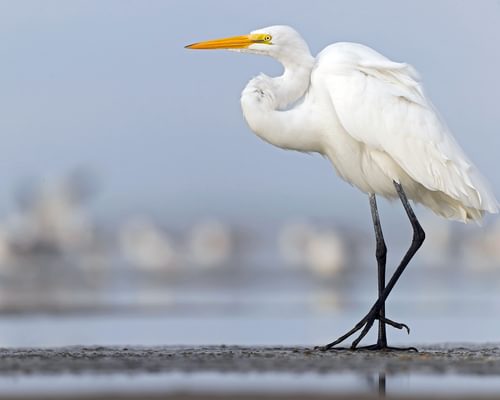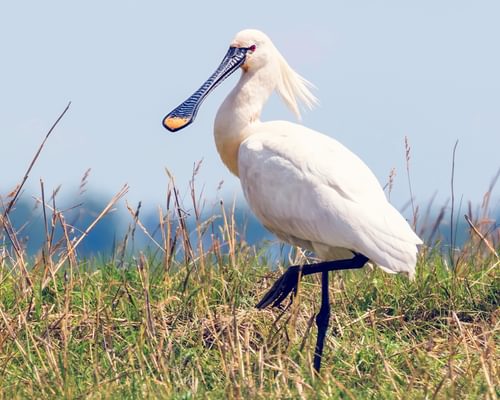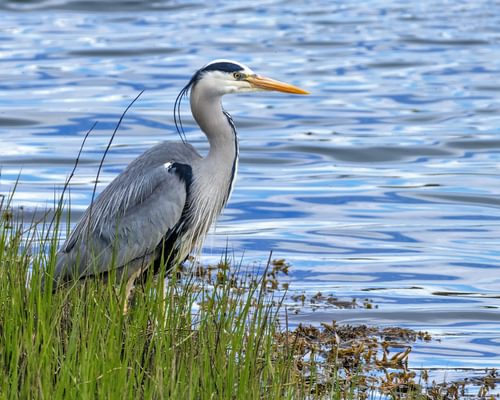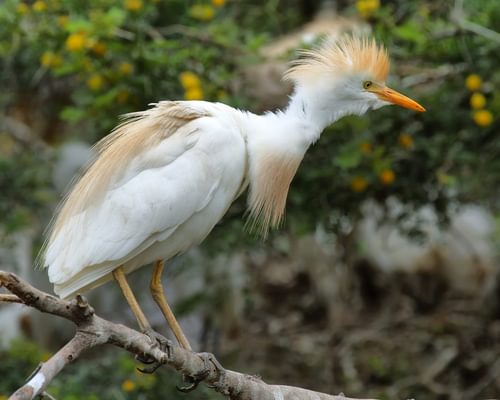Little Egret
Least ConcernEgretta garzetta
Visual Identification
Appearance
The Little Egret is a striking, medium-sized heron with pure white plumage. It has a slender dagger-like black bill, long black legs, and yellow feet.
During the breeding season, adults develop long, filamentous plumes on the crest, back, and chest.
Juveniles resemble non-breeding adults but may have duller legs and feet. Both sexes are similar in appearance, with females slightly smaller on average than males.
Size
Length
55cm to 65cm
Wingspan
88cm to 106cm
Weight
350g to 550g
Colours
Males and females have similar plumage
Primary Colour
White
Secondary Colour
Black
Beak Colour
Black
Leg Colour
Black Yellow
Habitat and Distribution
Habitats
Woodland
Garden
Wetland
Coastal
Urban
Farmland
Grassland
Desert
Tundra
Rainforest
Mountain
Savanna
Distribution
Little Egrets inhabit a wide range of wetland habitats, including coastal lagoons, estuaries, tidal mudflats, and inland freshwater bodies. They are found across Europe, Africa, Asia, and Australia.
In recent decades, their range has expanded northward in Europe. They are now regular visitors to the UK, with established breeding populations along southern and eastern coasts (Norfolk is an excellent area for spotting), and are occasionally seen in eastern North America.
Elevation Range
Up to 2,000 meters
Climate zones
Temperate, Tropical, Subtropical
Distribution Map
This map gives you a rough idea of where you might spot a Little Egret. The coloured areas show countries where these birds have been seen.
A few things to keep in mind:
- Birds might not be everywhere in the coloured areas, for example, they may be present around the coast of that country
- Where birds live can change with seasons and available food
- This map is quite simple - it doesn't show exact locations
We're working on making our maps even better! Soon, we hope to show you:
- More detailed maps for bigger countries, including state and region
- How birds move around during different seasons
Distribution by Region
Behaviour and Ecology
Bird Attributes
This feature is in beta. We'd love your feedback to improve it!
Share your thoughtsBird Attributes Explained
Our bird attributes system rates various aspects of a bird's capabilities on a scale of 0-100, based on data from field observations, scientific studies, and expert knowledge.
Attribute Categories:
- Agility: Manoeuvrability, speed, and grace in flight or movement.
- Strength: Physical power, often correlating with size and hunting abilities.
- Adaptability: Ability to thrive in various environments or changing conditions.
- Aggressiveness: Territorial behaviour and assertiveness, particularly during breeding seasons.
- Endurance: Stamina, often seen in migration patterns or foraging behaviours.
Understanding the Ratings:
- 0-20: Very Low
- 21-40: Low
- 41-60: Average
- 61-80: High
- 81-100: Very High
Remember, these attributes are relative to other bird species and don't necessarily indicate superiority.
Hover over the icon next to each attribute for more information.
Tap the icon next to each attribute for more information.
Agility
Reflects the bird's manoeuvrability, speed, and grace in flight or movement.
The Little Egret demonstrates considerable agility in its foraging techniques, employing various hunting methods and actively chasing small fish. Its ability to wade through shallow waters and use its feet to stir up prey indicates good manoeuvrability.
Strength
Indicates the bird's physical power, often correlating with size and hunting abilities.
Whilst not exceptionally strong, the Little Egret possesses adequate strength for its size. It can carry nesting materials and defend its territory during breeding season. However, its slender build suggests it's not among the strongest of birds.
Adaptability
Represents the bird's ability to thrive in various environments or changing conditions.
Little Egrets show remarkable adaptability, having expanded their range significantly in recent decades. They inhabit various wetland habitats and adjust their diet based on local food availability. Their ability to thrive in different climates further demonstrates their adaptiveness.
Aggressiveness
Measures the bird's territorial behaviour and assertiveness, particularly during breeding seasons.
Generally social birds, Little Egrets become territorial during breeding season. They're not known for exceptional aggression, but will defend their nests and young. Their moderate aggression is typical for their family.
Endurance
Reflects the bird's stamina, often seen in migration patterns or foraging behaviours.
Little Egrets display good endurance, capable of long-distance migrations and spending considerable time wading and foraging. Their ability to adapt to various climates and habitats suggests decent stamina, though they're not known for exceptional feats of endurance.
Diet
Little Egrets primarily feed on small fish, amphibians, and aquatic invertebrates. They also consume crustaceans, molluscs, and insects.
Their diet varies seasonally and geographically, adapting to local food availability. They often use their feet to stir up sediment, flushing out hidden prey and may half-run-half-fly in pursuit of prey in the shallows.
Behaviour
Little Egrets are often seen wading in shallow water, using their feet to stir up prey. They employ various hunting techniques, including standing still and waiting for prey or actively chasing small fish.
These birds are generally social, often roosting and feeding in groups, but become territorial during the breeding season.
Vocalisation
Little Egrets are generally quiet birds. During the breeding season, they produce various croaking and gurgling sounds at the colony.
When alarmed, they may emit a harsh, guttural 'ark' call. In flight, they occasionally make a soft 'kuik' sound. They also call when landing and while feeding and are frequently heard as they take off after being disturbed.
Nesting & Breeding
Little Egrets typically breed in colonies, often with other heron species. Pair formation begins in spring, with elaborate courtship displays involving head-bobbing and plume-raising.
Nests are stick platform structures usually built in trees or shrubs near water. Females lay 3-5 pale blue-green eggs, and both parents share incubation duties.
Eggs hatch after about 21-25 days. Chicks are altricial and fledge at approximately 40-45 days, becoming independent shortly after.
Lifespan
years
The Little Egret typically lives for 15 to 20 years.
Like all birds, lifespan can be affected by factors including predation, habitat quality, disease, and access to food sources.
Conservation and Status
Global Conservation Status
While the Little Egret is currently listed as Least Concern, it faces localised threats from habitat loss and degradation, particularly in wetland areas. Climate change may affect its distribution.
Conservation efforts focus on protecting and restoring wetland habitats, which benefit this species and many other water birds.
Birdwatching Tips
- Look for Little Egrets in shallow waters of coastal areas, estuaries, and inland wetlands
- Observe their distinctive yellow feet, which contrast with their black legs
- Watch for their active foraging behaviour, including foot-stirring to flush out prey
- In the UK, they are increasingly common along southern and eastern coasts
Additional Information
Quick Facts
Other names:
White Heron
Family:
ArdeidaePredators
Main predators include large birds of prey, such as eagles and hawks, as well as mammals like foxes and raccoons, particularly targeting eggs and chicks.
Did You Know?
- Little Egrets were once hunted extensively for their plumes, which were used in the fashion industry.
- They have rapidly expanded their European range over the past few decades.
- Their yellow feet may act as a lure to attract fish in murky water.
Was this bird profile helpful?
Your feedback helps us improve our content
Thanks for your feedback!
Your input helps us improve our content.
Community Experience
Community Ratings
No ratings yet - be the first to rate this bird!
Latest Community Reviews
No reviews yet
Sign in to be the first to review
Community Reviews
Create Your Free Account Welcome Back!
Join our community to rate birds and share your experiences. Creating an account is completely free and only takes a minute. Sign in to your account to rate birds and share your experiences with our community.
Your information is secure and will never be shared.
By creating an account, you agree to our Privacy Policy.
FAQs
Do you get Little Egrets in Scotland?
Little Egrets remain relatively uncommon in Scotland, although they are becoming increasingly numerous. These birds are a regular sight at places like the Montrose Basin and Solway Firth.
Similar Birds
References
- 1
website: BirdLife International. 2016. Egretta garzetta. The IUCN Red List of Threatened Species 2016: e.T62774969A86473701.
View source - 2 3
report, 2006: Wetlands International



